 With a big birthday in sight, it occurred to me that being with trees that are over 2000 years old might provide some much needed perspective. When the chance to ferret away a kid who had been in college all year presented itself, an unassuming weekend in June became the perfect chance to celebrate both my birthday and the 100th Anniversary of our National Parks. We spent two days exploring Sequoia National Park and Kings Canyon and the pull to return again – to explore more terrain and be once again in the thrall of the big trees – is profound. As President Obama said when he and the First Family visited Yosemite recently, there’s “something sacred” about these spaces.
With a big birthday in sight, it occurred to me that being with trees that are over 2000 years old might provide some much needed perspective. When the chance to ferret away a kid who had been in college all year presented itself, an unassuming weekend in June became the perfect chance to celebrate both my birthday and the 100th Anniversary of our National Parks. We spent two days exploring Sequoia National Park and Kings Canyon and the pull to return again – to explore more terrain and be once again in the thrall of the big trees – is profound. As President Obama said when he and the First Family visited Yosemite recently, there’s “something sacred” about these spaces.
We returned to Los Angeles, brimming with stories from our adventure, and the #1 question from friends was inevitably a slightly confused version of: “Where are those trees, again?” The answer: just 203 miles (three plus enjoyable hours) away by car.

Why Go?
The big trees. The largest living things on Earth. The wild terrain of the Sierra Nevada is largely unexplored. It’s that simple. The parks are full of more Europeans than Americans, seemingly. Tourists from France and Germany who recognized the value in traveling halfway across the globe to gaze upon treasures that lie in our backyard. We were amazed to learn that the parkland protected in the three big CA parks (Sequoia, Kings Canyon and Yosemite) is larger than all the Alps combined – Swiss, French and Italian. And it’s pristine.
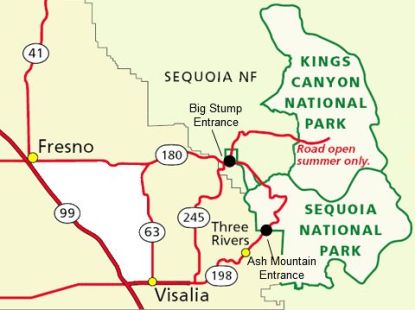
How to get there:
Your destination for the main entrance to the parks is Three Rivers, a delightful town along the Kaweah River reachable if you take route 198 out of Visalia. You can also enter the park from the north, via route 245, but Three Rivers is a treat in itself and the larger groves of Sequoia are at the southern entrance. Here are driving directions.
We set out on a Friday morning. Once we threaded the Grapevine and turned onto the charming and unassuming Route 99, we were in a different world.. The western side of the Sierras are as exotic to a city kid as the arid plains of the Owens Valley that we traverse enroute to Mammoth. But the farmland that slopes out to the Pacific is far more fertile and abundant.
The city of Visalia is a sprawling connection of strip malls and chain restaurants which may seem like a lot of Southern California but is actually a gateway to another world. Turning right out of town, we found ourselves cruising through manicured lemon and orange groves, with orderly green rows of fruit and vegetables that are routinely shipped off to the rest of America. Here abound serious farmers with vast acreage and powerful operations. Yet as we learned at a farmstand along the way, the best farms are run by guys that come down and work in the field every day, managing their operations the old-fashioned way. The taste of the strawberries and peaches was evidence that they know what they’re doing.
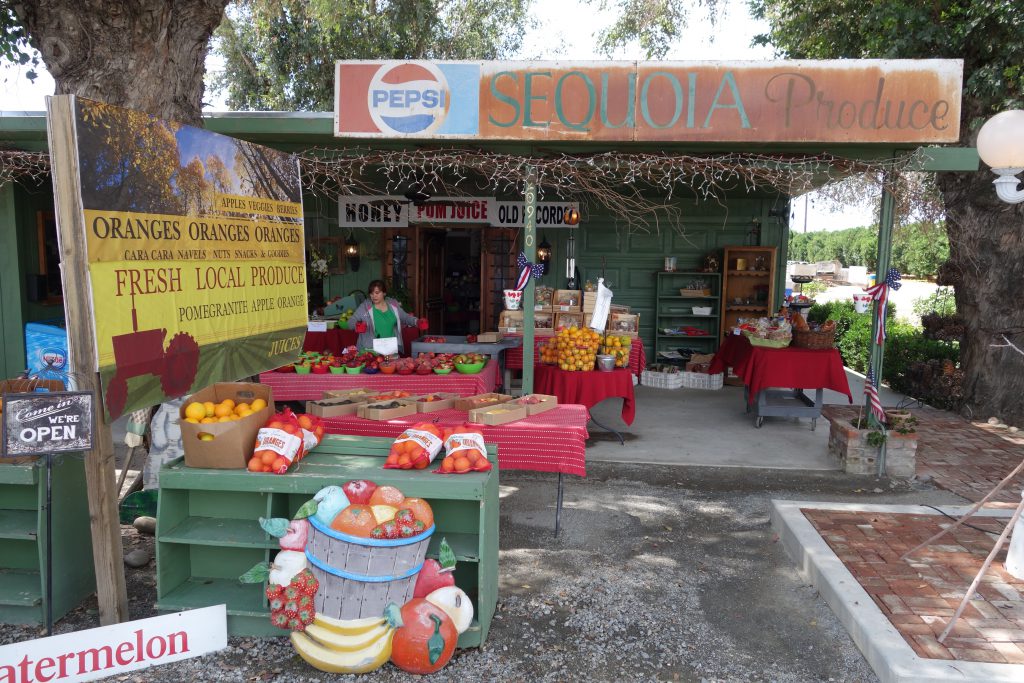
Climbing up from the valley floor, we passed Lake Kaweah (home of rickety wooden houseboats and day trippers) and climbed into the town of Three Rivers. The churning mountain stream dictated the road’s turns and gradually the houses increased in number and sophisticated. A few farms dotted the road, fences stretching up to the golden hills, and horses grazing amidst the trees. Then, a post office. A local pizzeria, and a small school and two gas stations. We had expected a bustling metropolis but Three Rivers turned out to be a funky little mountain town that is accustomed to accommodating the crowds that flock to the National Park. It was utterly charming – unspoiled in a way that perhaps Ojai was over 40 years ago.
We found a home through VRBO and stopped at a store to get provisions and seek advice about dinner from the locals. Ol’ Buckaroo was our favorite find – a food truck hitched up to a picnic area by the river.
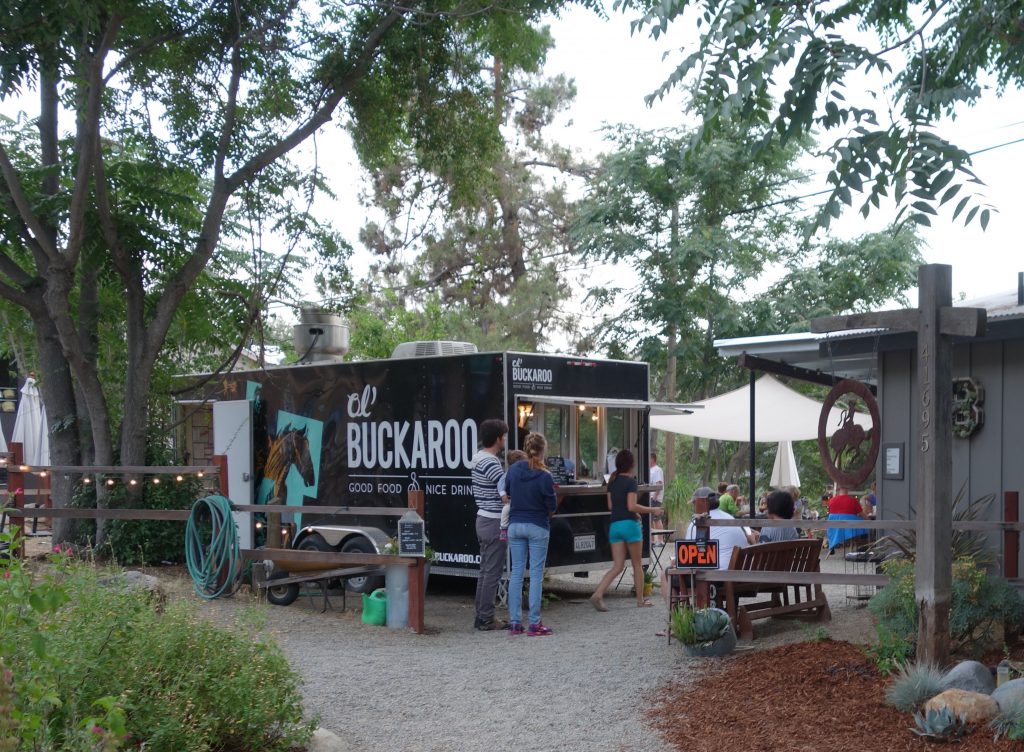
Day One – Into the Forest:
After meeting our landlord and dropping supplies, we bellied up to the main entrance of the park (buy a pass beforehand here; it’s cheap and you’re supporting the park!), and spending a solid half hour climbing by a hairpin turn switchback road seemingly straight up to the parkland. The air seemed to change as we ascended and then suddenly we found ourselves in a different climate. We were in the forest and saw our first Sequoia, rising above the road, glowing gold in the evening light. One turned to four or five, and stands of the giants set off to the side of the road. We were dizzy with the perspective shift, giddy when the road split through a cluster of four of the trees. Suddenly they were everywhere. It was a gorgeous drive, full of promise and mystery.
We found ourselves at Foothills Visitor Center with a few hours of daylight remaining. Because it was late on a Friday, we had the place to ourselves. If you bring kids (and even if you don’t) consider dropping in on a Ranger program. The visitor center is worth doing for a basic orientation to how Sequoias differ from Redwoods (both big, but not the same), how pinecones grow into big trees (thanks to carefully controlled fires) to how your perspective on size shifts immediately once amongst the giants. Here is a description from the invaluable NPS gov website: “It is difficult to appreciate the size of the giant sequoias because neighboring trees are so large. The largest of the sequoias are as tall as an average 26-story building, and their diameters at the base exceed the width of many city streets”.
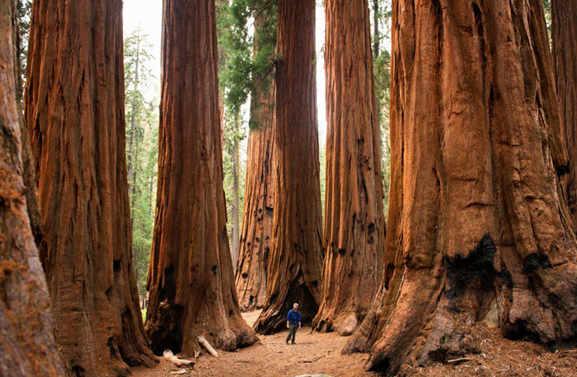
And they are like friendly giants. A peaceful mood came upon us immediately upon driving through The Giant Forest – a magical place, named by John Muir, where 8000 trees are clustered. The road winds through miles of “stands” of these trees, and hiking trails lure visitors back into other cathedral-like groves. The wonder is so simple – you are literally thrilled to be in their midst. These trees don’t grown anywhere else, except in this place, high above 5000 feet on the sidelines of the Sierras. It’s impossible not to feel grateful to Muir who spent his life exploring and advocating to preserve the trees. And yet, the miracle of the park is that for (most of) the time we spent in the park, we were able to feel the same wonder that inspired him to spend his life protecting these magnificent beings. It’s unspoiled and clean, pristine and, therefore, timeless.
Learn more about John Muir here.
We did all the sites. We gawked at The General Sherman Tree– the largest on Earth – and waited patiently with a dozen folks on a simple boardwalk for our photo against the trunk. We explored the glorious meadow of the Big Trees Trail to ourselves as the sun set, and marveled at the numerous tiny cones that foster these behemoths. The next day, we followed General’s Highway through the park to gaze upon The General Grant Tree. And we rode town a bumpy road to see The Redwood Forest, where park rangers were gathered to learn about setting deliberate fires in order to encourage new cones to open, and control the undergrowth.
Here are itineraries for one day, 2-3 day and week long trips.
Day Two -Views Forever
 The next morning, we headed up the switch back again to climb the dominant feature of this side of the park – Moro Rock. With 360 steps from parking lot to glorious precipice in space, this is one of the park’s MUST DO events. Moro beckons to be conquered, it’s peak higher than 7000 feet, but with a solid set of concrete steps that make it relatively easy to climb. It’s been designated on the National Registry of Historic Places and the bragging rights are notable.
The next morning, we headed up the switch back again to climb the dominant feature of this side of the park – Moro Rock. With 360 steps from parking lot to glorious precipice in space, this is one of the park’s MUST DO events. Moro beckons to be conquered, it’s peak higher than 7000 feet, but with a solid set of concrete steps that make it relatively easy to climb. It’s been designated on the National Registry of Historic Places and the bragging rights are notable.
 Views of all of the Sierra’s dominate to the East and the long luscious valley through which we ascended laid out to the West. Surprisingly, there are many dead trees up this high – the drought has really taken its toll on the area, and the trees that haven’t died have been infested with beetles. N.B. There are shuttle busses that loop all day into the base of Moro, or you can hike the loop to Moro and back from The Foothills Visitor Center.
Views of all of the Sierra’s dominate to the East and the long luscious valley through which we ascended laid out to the West. Surprisingly, there are many dead trees up this high – the drought has really taken its toll on the area, and the trees that haven’t died have been infested with beetles. N.B. There are shuttle busses that loop all day into the base of Moro, or you can hike the loop to Moro and back from The Foothills Visitor Center.
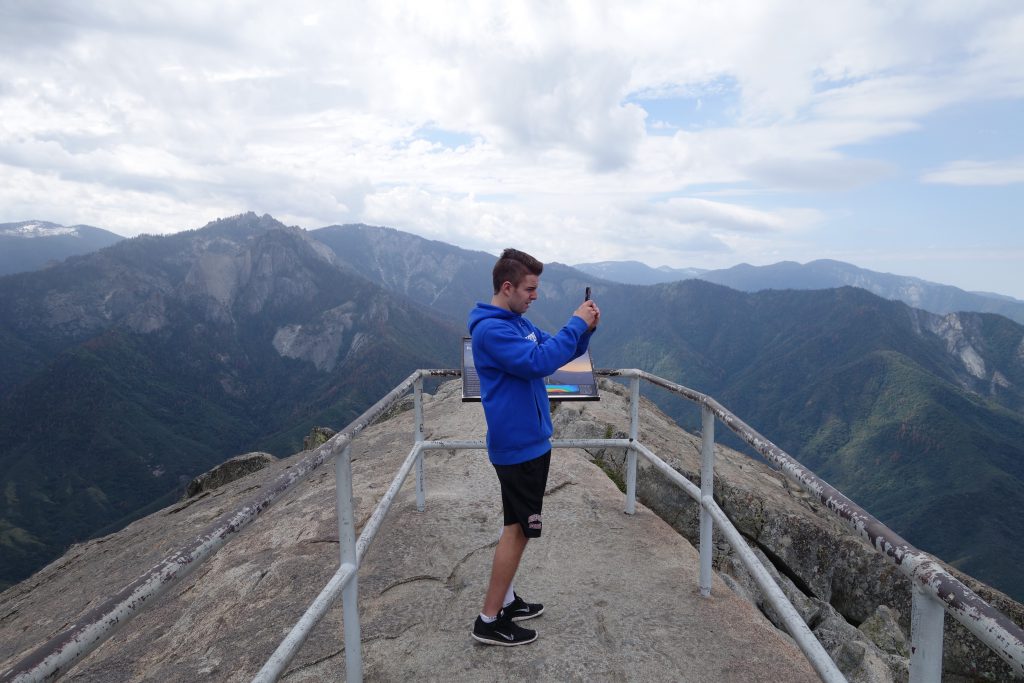
One of the nice features of this trip is that you can do a lot of it by car, which we had to do because my son had just had ACL surgery (but still, he scrambled all the way up to Moro for those views and a great selfie!). We will certainly return when we can do more back country exploration – there are wonderful one-hour and day hikes, as well as major expedition launch points in the park. More about the hiking here.
Kings Canyon: Unspoiled and Wild
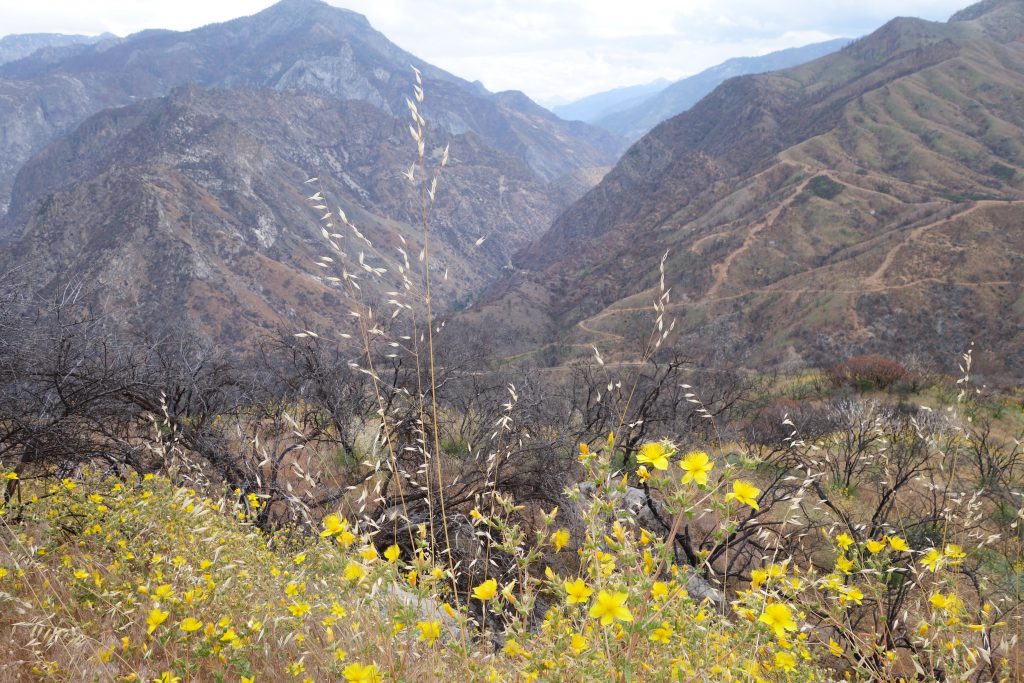
After Moro, we traversed the length of Generals Highway out of Sequoia National Park, through the Sequoia National Forest, to King’s Canyon. Interestingly, the land is very different in the northern part of the park. While there are still Sequoias in King’s Canyon, the scenic half-day trip into the heart of King’s Canyon (to Cedar Grove) moves from the high tree area, to more arid and rough back country, where seriously winding roads and spectacular views are the draw for visitors.
But the drive is not for the faint of heart. This part of California feels utterly wild. Unexplored, perhaps charted, but remote and authentically wild. If you are at all queasy about driving, do not foray to the far reaches of Cedar Grove – the road spins along the side of vast cliffs and it’s a case of concentrating on the drive and not getting caught up in the views. We had our heart in our mouth on most turns but continued only because of the splendor of the views and promise of a waterfall. N.B. There is absolutely no cell service back this far.
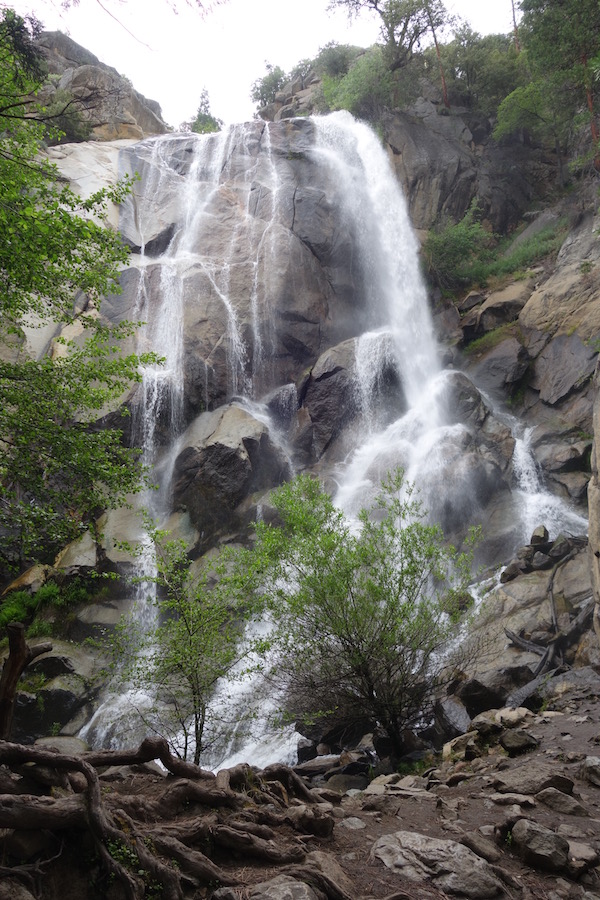
Eating:
We loved Ol’Buckeroo for grub in Three Rivers, and recommend stopping in Bakersfield on the way home for terrific, authentic tacos at Los Tacos De Huicho. Lines around the block!

The Upshot: Disney and Being Unplugged
If you aren’t convinced of the magic of this place, consider that one of Walt Disney’s unrealized dreams was to put a ski resort in the area called Mineral King. After a battle that took nearly ten years, he lost out to wilderness preservationists (the spirit of John Muir lives on). Here is a chronicle of the battle. In the end, because national parkland already bordered three sides of the Mineral King Valley, the area was eclipsed into the park and the treacherous one-way road to Mineral King – which was supposed to become a superhighway – keeps away most tourists except serious hikers to this day. But the case went to the Supreme Court and is heralded by legal scholars as a key one for environmental legislation.
Remember, this was a road-trip with a 20 year old college boy and a mom on the precipice of what we’ll just call “a big birthday”. The sound track was governed by the younger, but the itinerary and conversation was classic. We marveled at the mountains, we talked about the farmers, and thought about the contrast to the lives we’d been leading only a hundred miles to the South. As with all trips, the more we left our world behind, the less we looked at the phones or made calls back to our lives, and the more we gazed out the windows at the increasingly foreign landscape. Turns out, no being connected to the Internet continuously was “really relaxing” – the words of a kid who is rarely untethered.
It’s possible I dragged my son to the woods to find perspective on my “big birthday” – after all, how can you feel old when these trees have been around for 2000 years? But in the end, age melts from the mind and the sense of wonder is all that matters. It’s why we climb into the hills, to marvel at the glory of the Earth, to forget ourselves. And to wonder.
Know Before You Go:
The park websites are the best, and we also relied upon paper maps and guidebooks religiously. Not just because we didn’t always have wifi, but because you can feel the sweep and range of the land better when a map is spread on your lap.
Here’s an advice-riddled article from the New York Times called “10 Months, 45 National Parks, 11 Rules” if you need further inspiration.
I particularly like the bit about “Go Where the Tourists Go. And Where They Don’t” because why go if you don’t see the highlights? But, what makes any journey memorable is the discovery of something new, the exploration into something new and unknown. And those moments happen when you let go of schedules, and cellphone service, and forage around the unspoiled corners.

